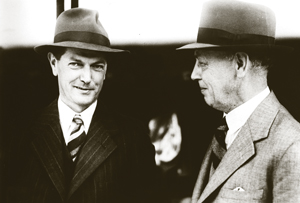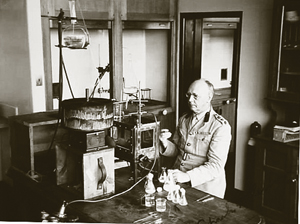Personal courage is most memorable when an individual shines in a time of crisis, but the quiet sacrifices of a lifetime devoted to duty are too often lost to posterity. Such seems to have been the fate of Charles Halliley Kellaway (1889–1952), who pioneered the path of independent medical research in Australia during the difficult decades after World War I.1
The close of 2007 provides good reason to reflect on Kellaway’s successes, especially as we recall the 80th anniversary of two pivotal events in Australian medical research. In 1927, the first Commonwealth grant for medical research was approved, while in 1928, a royal commission into the iatrogenic “Bundaberg tragedy” significantly heightened public appreciation of medical science. Kellaway was the central figure in both of these events, yet they formed only a small part of his contribution to Australian medical history (Box).1-14
Much of Kellaway’s character can be traced to his origins. Born in Melbourne into the family of a country clergyman, Kellaway was instilled with evangelical zeal and a lingering Victorian faith in duty and progress. While consistently topping his university courses via hard-won scholarships, Kellaway set his sights on becoming a medical missionary in India. Although he was clearly ambitious, the most enduring memory of Kellaway — recalled by all who met him — was his affability and willingness to assist others.1,15,16 These qualities were all to be tested during World War I.
Despite the prevailing imperial fervour, Kellaway’s decision to enlist was not taken lightly. He completed his postgraduate Master of Surgery and Doctor of Medicine degrees before signing up in late 1915, arriving in the Middle East just after the evacuation of Gallipoli.17 Here, he worked as a pathologist alongside the director of the Lister Institute, Charles Martin, who had undertaken pioneering research in physiology, including snake venom studies, in Australia at the turn of the century.11
In 1917, Kellaway joined the Australian Imperial Force in France as regimental medical officer for the 13th Battalion. After a battle at Zonnebeke on 26 September, he earned the Military Cross, his commanding officer noting: “During the 24 hours following the attack he worked without a moment’s respite, dealing with the wounded of five battalions in addition to his own, and at the same time controlling the work of his Stretcher Bearers. He established what must be a record by passing 400 cases through his R.A.P. [regimental aid post] in 24 hours. I cannot praise too highly his untiring devotion to duty”.17 Posted to London in 1918, Kellaway found himself working for the Royal Flying Corps and its Australian counterpart. His investigations into the physiology of anoxaemia — then a problem for military aviators — led to Kellaway’s first serious scientific research and a fortuitous association with Henry Dale, Britain’s leading pharmacologist.1,8
Although his experiences at the front converted Kellaway to agnosticism, his wartime work with Martin and Dale redirected his energies to a new calling — the betterment of humanity through medical research. After the war, these two mentors saw Kellaway appointed as a Foulerton scholar of the Royal Society. From 1920 to 1923, he undertook a tour of duty through many of the major English laboratories, mastering experimental techniques in physiology, pharmacology, immunology, biochemistry and pathology.1
In 1923, the directorship of Melbourne’s nascent Walter and Eliza Hall Institute of Research in Pathology and Medicine (as it was then known) became vacant. The WEHI at this point was the only independent centre for medical research in Australia, comprising fewer than a dozen staff and a paltry annual budget of £2500.15 Both Martin and Dale proposed Kellaway for the post, noting his superior research qualifications over those of the other candidate.15,18
Of broader significance, Kellaway also pioneered the system of Commonwealth sponsorship for medical research programs. In late 1927, he approached the Minister for Health, Neville Howse, and the powerful Director-General of the Department of Health, John Cumpston, with a proposal. Kellaway sought federal funding for a range of projects, including research into polio, hydatid disease and snake venoms.22,23 Cumpston was generally equivocal about the value of funding research,5,24 but enthusiastically supported Kellaway’s requests, and several grants ensued. Although most federal finance trickled away during the Depression, a precedent had been set. The willingness of the Commonwealth to support medical science at the WEHI not only assisted Kellaway in establishing a new virus research department for Burnet in 1934, but helped pave the way for the National Health and Medical Research Council (NHMRC) in 1936.15,22,23,25
The 1920s were a halcyon decade for pharmacological and physiological research, and Kellaway’s Foulerton scholarship brought him into the laboratories of Britain’s leading researchers, especially Henry Dale. Kellaway and Dale collaborated on a series of elegant experiments that confirmed the immunological basis of anaphylaxis, but determined that its physiological effects were not the result of proteinaceous “anaphylatoxins”, as was generally supposed. Rather, their work led to an appreciation of the primacy in anaphylaxis of histamine, which Kellaway further explored in subsequent collaborations during his English sojourn.1 Tissue injury and anaphylaxis remained significant themes throughout Kellaway’s career, although he did not return to a concerted study of their underlying physiological processes until the late 1930s.
When World War II broke out, Kellaway’s personal research career effectively ended, but not before his work in venoms was recognised internationally, including by a coveted Royal Society of London fellowship and an invited series of Dohme lectures at Johns Hopkins University in 1936.12-14 During the war, Kellaway rejoined the Australian Army, first as Director of Pathology and later as Honorary Scientific Liaison Officer, where his experience and contacts helped with coordination of local and international military research programs.
The key achievements of Charles Halliley Kellaway (1889–1952)
Received 23 September 2007, accepted 29 October 2007







Abstract
Charles Halliley Kellaway (1889–1952) was one of the first Australians to make a full-time career of medical research.
He built his scientific reputation on studies of snake venoms and anaphylaxis.
Under Kellaway’s directorship, the Walter and Eliza Hall Institute gained worldwide acclaim, and he played a critical role in its success between the world wars.
His administrative and financial strategies in the era before the National Health and Medical Research Council (NHMRC) helped local medical research weather the Depression and gain a strong foothold by World War II.